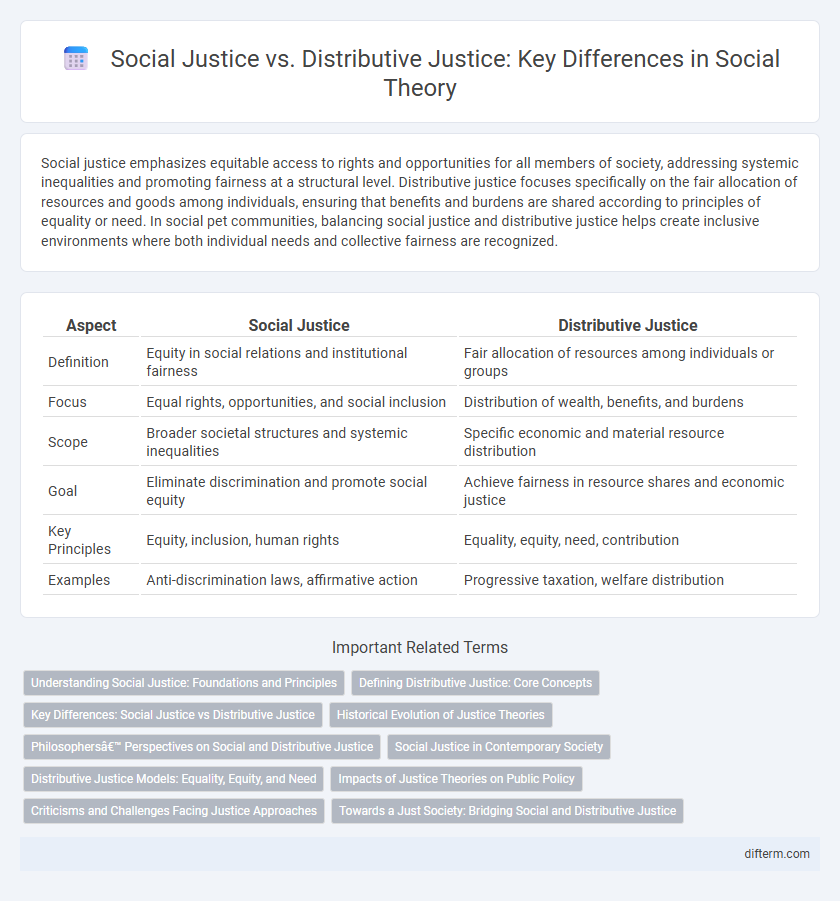Social justice emphasizes equitable access to rights and opportunities for all members of society, addressing systemic inequalities and promoting fairness at a structural level. Distributive justice focuses specifically on the fair allocation of resources and goods among individuals, ensuring that benefits and burdens are shared according to principles of equality or need. In social pet communities, balancing social justice and distributive justice helps create inclusive environments where both individual needs and collective fairness are recognized.
Table of Comparison
| Aspect | Social Justice | Distributive Justice |
|---|---|---|
| Definition | Equity in social relations and institutional fairness | Fair allocation of resources among individuals or groups |
| Focus | Equal rights, opportunities, and social inclusion | Distribution of wealth, benefits, and burdens |
| Scope | Broader societal structures and systemic inequalities | Specific economic and material resource distribution |
| Goal | Eliminate discrimination and promote social equity | Achieve fairness in resource shares and economic justice |
| Key Principles | Equity, inclusion, human rights | Equality, equity, need, contribution |
| Examples | Anti-discrimination laws, affirmative action | Progressive taxation, welfare distribution |
Understanding Social Justice: Foundations and Principles
Social justice centers on equitable access to rights, resources, and opportunities across diverse populations, emphasizing fairness in societal treatment and systemic equity. Distributive justice specifically addresses the allocation of wealth, resources, and burdens within a community, ensuring that distribution aligns with moral or ethical principles of fairness. Understanding social justice requires recognizing its foundation in human rights, inclusivity, and the elimination of social inequalities that perpetuate discrimination and marginalization.
Defining Distributive Justice: Core Concepts
Distributive justice concerns the equitable allocation of resources, opportunities, and burdens across society, emphasizing fairness in how wealth, power, and privileges are shared. Core concepts include equality, equity, and need, guiding decisions about who deserves what based on merit, contribution, or basic entitlements. This framework contrasts with broader social justice, which integrates distributive principles with rights, recognition, and systemic fairness beyond mere resource distribution.
Key Differences: Social Justice vs Distributive Justice
Social justice emphasizes equal rights, opportunities, and treatment within society, addressing systemic inequalities rooted in race, gender, and class. Distributive justice focuses specifically on the fair allocation of resources and wealth among individuals or groups, ensuring equitable economic distribution. While social justice encompasses broader social equity concerns, distributive justice targets material fairness in resource management and policy implementation.
Historical Evolution of Justice Theories
The historical evolution of justice theories reveals a shift from distributive justice, focused on equitable allocation of resources, to more complex social justice frameworks addressing systemic inequalities. Early philosophies such as Aristotle's notion of distributive justice emphasized proportional fairness, while 20th-century theorists like Rawls introduced principles of social justice centered on fairness and equality in societal structures. This evolution reflects growing recognition of social justice's role in combating discrimination and promoting inclusive policies beyond mere resource distribution.
Philosophers’ Perspectives on Social and Distributive Justice
Philosophers like John Rawls emphasize distributive justice by advocating for fair allocation of resources to ensure equality and protect the least advantaged, while social justice thinkers such as Iris Marion Young focus on rectifying systemic oppression and ensuring participatory democracy. Rawls' theory of justice centers on principles derived from the original position and veil of ignorance, prioritizing economic distribution. In contrast, Young critiques distributive justice for overlooking social structures and power imbalances that underlie inequality, thus broadening the discourse to include recognition, representation, and institutional reform.
Social Justice in Contemporary Society
Social justice in contemporary society emphasizes equitable access to opportunities, resources, and rights, aiming to dismantle systemic inequalities rooted in race, gender, and socioeconomic status. It prioritizes recognizing and addressing power imbalances and institutional discrimination to create inclusive environments for marginalized communities. Advocacy movements and policy reforms increasingly focus on social justice to promote participation, equity, and respect for human dignity across diverse populations.
Distributive Justice Models: Equality, Equity, and Need
Distributive justice models address the fair allocation of resources by emphasizing different principles: equality ensures identical shares for all, equity allocates resources based on individual contribution or merit, and need focuses on distributing according to recipients' specific requirements. These frameworks shape policies and social programs by defining what is considered just distribution within various social contexts. Understanding distinctions among equality, equity, and need is essential for designing systems that promote fairness and reduce social disparities effectively.
Impacts of Justice Theories on Public Policy
Social justice emphasizes fairness in societal rights and opportunities, influencing policies aimed at reducing inequality and promoting inclusive access to resources. Distributive justice focuses on the equitable allocation of wealth, services, and burdens, shaping public policies that determine resource distribution based on need, merit, or equality. These justice theories impact public policy by guiding legislative priorities, welfare programs, and taxation systems to address social disparities and enhance collective well-being.
Criticisms and Challenges Facing Justice Approaches
Social justice often faces criticism for its broad and sometimes vague goals, which can lead to disagreements about what constitutes fair treatment among diverse groups. Distributive justice is challenged by competing views on how resources should be allocated, raising debates on equality versus equity models. Both approaches struggle with implementing policies that balance individual rights and collective welfare in complex social systems.
Towards a Just Society: Bridging Social and Distributive Justice
Bridging social justice and distributive justice requires addressing both the equitable distribution of resources and the elimination of social inequalities rooted in systemic discrimination. Achieving a just society involves policies that promote equal opportunities, recognize diverse social identities, and ensure fair access to education, healthcare, and employment. Integrating principles of fairness, equity, and inclusion fosters social cohesion and sustainable progress in achieving comprehensive justice.
social justice vs distributive justice Infographic

 difterm.com
difterm.com